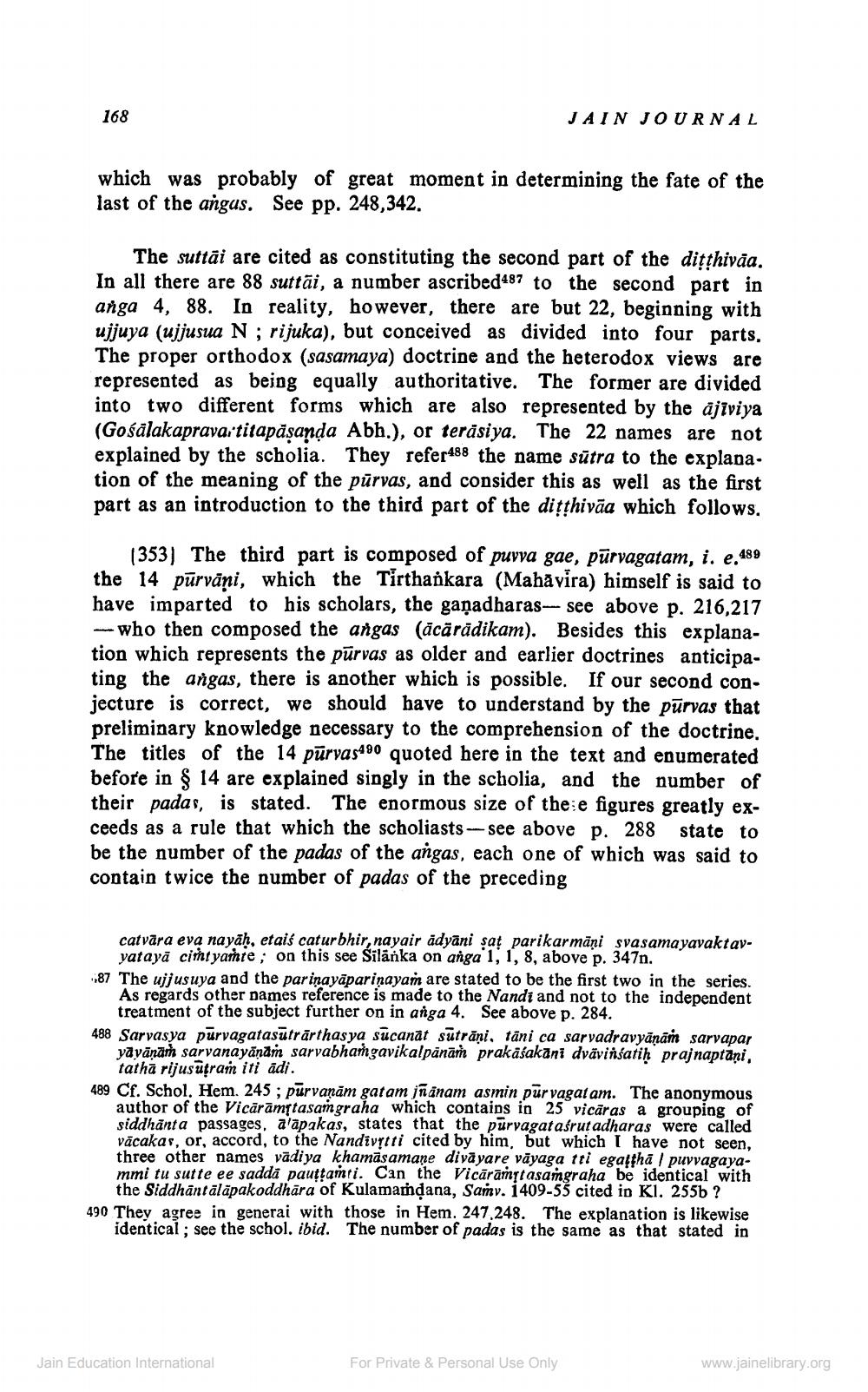Book Title: Jain Journal 1993 04 Author(s): Jain Bhawan Publication Publisher: Jain Bhawan Publication View full book textPage 7
________________ 168 JAIN JOURNAL which was probably of great moment in determining the fate of the last of the angus. See pp. 248,342. The suttăi are cited as constituting the second part of the ditthivaa. In all there are 88 suttâi, a number ascribed487 to the second part in anga 4, 88. In reality, however, there are but 22, beginning with ujjuya (ujjusua N; rijuka), but conceived as divided into four parts, The proper orthodox (sasamaya) doctrine and the heterodox views are represented as being equally authoritative. The former are divided into two different forms which are also represented by the äjiviya (Gośālakapravartitapāsanda Abh.), or teräsiya. The 22 names are not explained by the scholia. They refer488 the name sūtra to the explana. tion of the meaning of the pūrvas, and consider this as well as the first part as an introduction to the third part of the ditthivāa which follows. 1353) The third part is composed of puvva gae, pūrvagatam, i. e.489 the 14 pūrvāni, which the Tirthankara (Mahavira) himself is said to have imparted to his scholars, the gañadharas- see above p. 216,217 -- who then composed the angas (ācārädikam). Besides this explana. tion which represents the pūrvas as older and earlier doctrines anticipating the angas, there is another which is possible. If our second conjecture is correct, we should have to understand by the pūrvas that preliminary knowledge necessary to the comprehension of the doctrine. The titles of the 14 pūrvas490 quoted here in the text and enumerated before in § 14 are explained singly in the scholia, and the number of their padas, is stated. The enormous size of the e figures greatly exceeds as a rule that which the scholiasts -- see above p. 288 state to be the number of the padas of the angas, each one of which was said to contain twice the number of padas of the preceding catvāra eva nayāḥ, etaiś caturbhir, nayair adyani şat parikar māņi svasamayavaktav yatayā cintyante ; on this see Silänka on anga 1, 1, 8, above p. 347n. -87 The ujjusuya and the parinayāparinayam are stated to be the first two in the series. As regards other names reference is made to the Nandi and not to the independent treatment of the subject further on in anga 4. See above p. 284. 488 Sarvasya purvagatasūtrarthas ya sucanat sutrāni, tāni ca sarvadravyānām sarvapar yāyānā sarvanayānan sarvabhagavikalpanań prakāśakani dvävinsatih prajnaptani, tathā rijusutram iti adi. 489 Cf. Schol. Hem. 245; purvanām gatam iñanam asmin purvagat am. The anonymous author of the Vicārāmftasamgraha which contains in 25 vicāras a grouping of siddhānta passages, alapakas, states that the purvagataśrut adharas were called Vācakas, or, accord, to the Nandivytti cited by him, but which I have not seen, three other names vādiya khamasamane divāyare vāyaga tti egalthā / puvvagayammi tu sutte ee sadda pauttamri. Can the Vicärāṁytasangraha be identical with the Siddhāntālāpakoddhāra of Kulamamdana, Sañv. 1409-55 cited in Kl. 255b ? 490 They agree in generai with those in Hem. 247,248. The explanation is likewise identical ; see the schol. ibid. The number of padas is the same as that stated in Jain Education International For Private & Personal Use Only www.jainelibrary.orgPage Navigation
1 ... 5 6 7 8 9 10 11 12 13 14 15 16 17 18 19 20 21 22 23 24 25 26 27 28 29 30 31 32 33 34 35 36 37 38 39 40 41 42 43 44 45 46 47 48 49 50 51 52 53 54 55 56 57 58 59 60 61 62 63 64 65 66 67
